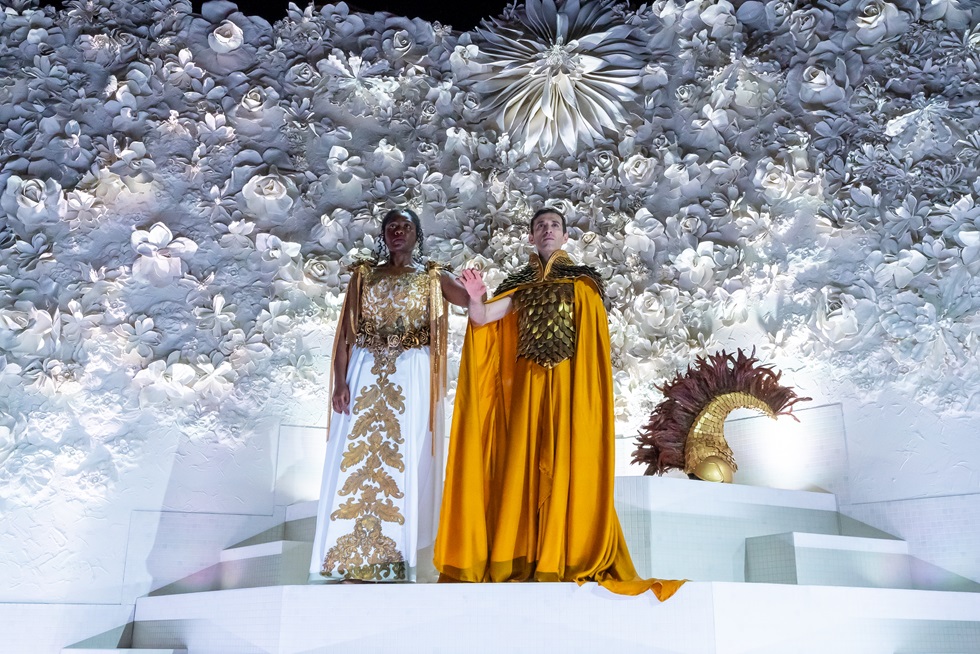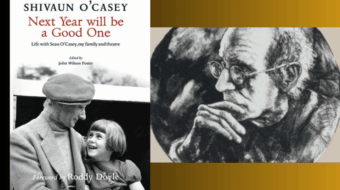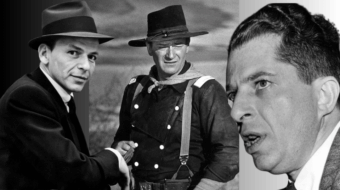
LOS ANGELES — Six years after Yuval Sharon and his opera company the Industry staged performances of experimental composer John Cage’s Europeras 1 & 2, the idea of chance once again strikes the modern opera world.
As the Trump years deepened, Sharon (pronounced Sha-RONE) and his partners in operatic production Anthony Roth Costanzo and Cath Brittan, The Industry, AMOC (American Modern Opera Company), and Curtis Institute of Music were thinking about reimagining L’incoronazione di Poppea (The Coronation of Poppea), an Italian opera by Claudio Monteverdi with a libretto by Giovanni Francesco Busenello, first performed in Venice in 1643. That opera, one of the earliest that still holds the modern stage, eviscerated the morals of ancient Rome, specifically of the authoritarian Emperor Nero, who unceremoniously either murders or exiles two previous wives in order to succumb to the amatory wiles of Poppea, whom he wishes to install on the throne.

Modern audiences might not appreciate this, but the very act of writing this opera, and staging it in Venice, was a direct satirical dagger pointed at the dominant merchant class of this major international trading port city at the time, who similarly engaged in all kinds of skullduggery to maintain and advance their élite positions. Monteverdi and his librettist were radicals of their day, talking about power, class, gender roles, servitude, and murder with impunity.
But opera of that period is something few audiences flock to these days, with its series of mostly solo arias with its many times repeated phrases. Its tedium is an art that one must learn to love. So Sharon et al. were looking to pair it with another opera in what might be called a “mashup,” to illuminate the values and ideas of one age by matching or contrasting them with another. In conversation with the Black American composer George Lewis, Yuval happened to ask what Lewis was reading these days. Lewis answered that he was reading the short story The Comet, which was Chapter 10 of Black historian and sociologist W.E.B. Du Bois’s 1920 Darkwater: Voices From Within the Veil. The Comet came to be regarded as a forerunner of the genre known as Afrofuturism and is also a seminal text in another genre, Afropessimism. The editors of the 2000 anthology Dark Matter: The Anthology of Science Fiction, Fantasy, and Speculative Fiction by Black Writers included this story, which relaunched interest in it.
So this more or less chance conversation gave rise to the fusion of the operatic work Lewis proceeded to write on The Comet with the Poppea conceit Sharon and company already had in mind. The resulting work, The Comet/Poppea enjoyed its much anticipated world premiere production at the Museum of Contemporary Art (MOCA) in downtown L.A. running for 11 performances June 14-23 (seen June 16).
Can two operatic genres, one with characters from the classical world, with featured appearances by the gods of Love, Virtue, and Fortune, be staged simultaneously, and successfully, with a second narrative filled with everyday modern characters? Yes, this is possible, as Richard Strauss and his librettist Hugo von Hoffmansthal proved in their opera Ariadne auf Naxos, dating from 1912 in its first, unwieldy version, and from 1916 in its revised version which is the one still performed.
MacArthur fellow Sharon is no newcomer to shaking up the opera world and forcing it to regard this often precious artistic form in a new light. Two years ago, at Detroit Opera, he flipped the time frame for Giacomo Puccini’s beloved La Bohème by staging it backward, from the final death scene in Act 4 retrospectively through time and the tangled relationship between Rodolfo and Mimi, to their first accidental and ecstatic meeting in a Parisian garret in Act 1—much as Stephen Sondheim’s Merrily We Roll Again also traces a Broadway artist’s current commercial sell-out success back to the McCarthy days when he and his friends were trying to use their talents to contribute to the political resistance.
The Comet, with a libretto by poet Douglas Kearney, is set in New York City during the 1920s after a comet hits the Earth and seemingly leaves a Black man (Jim) and a white woman (Julia) as the only survivors, while The Coronation of Poppea unfolds amid social divisions in ancient Rome. “Many parallels between these two cities have been considered over the centuries so that pairing comes with a kind of doubling,” says composer George Lewis. “The Comet/Poppea plays with that dynamic: the two stories start to unfold in parallel worlds of time and space. As the piece goes on, those two worlds start to leak into each other. Drawing on Du Bois’s own concept of double consciousness, the opera is structured around a number of these doublings.”

Jim, a Great Migration migrant from Alabama, works as a messenger who, after the comet implodes, goes onto the roof of a building where he sets off flares as a sign of life to other possible survivors. He enters the penthouse restaurant through a still working elevator, and a radio is still playing—music from Poppea. Killed on impact as they were dining, the restaurant patrons are now lying about dead, and he covers each face with a cloth napkin as he sings:
I woke up this morning, I was buried in a vault,
worthless when I lay and rose precious to a fault.
Today I’m king of ruin and this tomb’s my royal sphere.
And yesterday they would not have served me here.
Where I come from, disaster is a home away from home.
I visit on vacation and I stay there when I roam.
When I swear I’m fixed to leave, I know I’m nearly there
And yesterday they would not have served me here.
Julia also enters from the elevator, and they are wary of one another at first, only slowly recognizing their mutual status as survivors. For all they know, they may have to repopulate the Earth, à la Adam and Eve, or like the later Noah and his wife and family following the Flood.
All the while, “On a constantly rotating stage, two worlds unfold simultaneously, spinning like a top that creates a visual and aural spiral, inviting associations, dissociations, collisions, and confluences,” says director Yuval Sharon. “The Comet/Poppea begins as a critique of the institution of opera and ends as a justification of the art form’s radical potential: in the unexpected harmony to be discovered in juxtaposition and its ability to invite a contemplation of both timely and timeless struggles.”
An operatic adaptation is actually suggested in Du Bois’s original story: He has Jim recalling how he once found himself seated at a performance of Wagner’s Lohengrin at the Metropolitan Opera in New York when an usher comes along asking him to leave as the other patrons feel uncomfortable by his Black presence. A $5 bill is supposed to compensate him for his expulsion.
The audience for Comet/Poppea was divided into an East and West seating, so that as the carousel turned the audience could watch the classical set, complete with a bathing pool, spin from view, and become the tony 1920s restaurant. The ten-piece orchestra off to one side, conducted by Marc Lowenstein, including such instruments as harpsichord, baroque cello, and theorbo, combine with more traditional orchestra instruments for the fused Monteverdi-Lewis score. The cyclical production, as though we were watching time, space, and civilizations endlessly roll past our eyes, could have evoked many interpretations among viewers—the essential unity of the two works in addressing social issues, or the part disaster plays in history. (Don’t forget, this is the same Emperor Nero who not only later had his own Empress Poppea killed but was also, at least anecdotally, found on a hilltop overlooking Rome playing his violin as the barbarians sacked and set fire to the city. Perhaps the term “barbarians” should be revisited—could these perhaps be better described as colonized peoples of the Roman Empire, speakers of other languages besides Latin, who seized their opportunity to destroy the oppressive Metropolis at a vulnerable moment of visible, irreversible decline?)
What the carousel evoked for me were less ethereal, philosophical considerations: It made a steady ratcheting noise all throughout the 90-plus minutes of the production, making me think that while the cast onstage were rhapsodizing about love and destiny and fate, and race, status, exile, murder and empire, the essential wheels of history were audibly turning—the work ordinary, nameless, unremembered people do day in and day out, in ancient times, in the 1920s, and to this day. Perhaps these folk—the “barbarians,” the farmers with their plows, the sailors with their oars, the slaves who built the temples and forums—are the ones who need to be more recognized in the opera house. (And might it bring more audience into the operatic orbit—not just the opera house as such—if they saw their own stories portrayed in music and drama?)
It turns out that the comet didn’t destroy all life on Earth, just most people in New York City. Julia’s father J.B.H. shows up—he had been out of town in his Mercedes when it hit—and, seeing Jim, suspiciously and instinctively asks, “And what’s he been up to with you alone up here?” Julia assures her father that Jim is “the messenger / turned into the deliverer. / It’s his rockets called you here / and brought us back together.” And she is eager to return to her former life with her fiancé and her sister once again.
“I thank you, Jim,” the top-hatted J.B.H. says, looking like the Monopoly real estate mogul. “I’ve always liked your people,” he tells him magnanimously and holds out a substantial clutch of money. “If you ever want a job, call.”
And thus the racial hierarchy is restored, Du Bois’s “double consciousness” returning after a brief moment when it seemed it might have evaporated in the comet’s wake. At the end, Jim’s wife Nellie appears—she, too has been spared, though not their little baby girl, whose tiny body she is carrying and whom she rhapsodizes with a blues aria:
O sweet little Elsie.
Go to sleepy, baby,
keep the sweetness inside you.
Don’t weep, baby rest those crying eyes:
what’s there to see when you’re waking?
They take and they take and they take and they take all you see. Go sleepy
but still you’ll find no peace.
For they’ll come while you sleep and steal all your dreams.
But maybe in death they will leave Elsie be—
so sleep.

Still, librettist Douglas Kearney writes in his program note, “The nature of change…haunts this libretto…. See: The Comet/Poppea isn’t an exercise of pessimism, but an opportunity to play the changes in the changing same. Like folklore, like the Blues, or like a comet come around again, there’s always something to learn with another telling. Finding oneself at a crossroads simply increases the likelihood that something will come around.”
The fine, virtuosic cast (on June 16) featured countertenor Anthony Roth Costanzo as Nero, and then, pointedly at the end of Comet, as the imperial(ist) J.B.H. Costanzo is a member, with Sharon, of American Modern Opera Company (AMOC), and is world-famous for portraying Akhnaten in Philip Glass’s eponymous opera. As Jim we heard the commanding bass-baritone voice of Davóne Tines, who also appears regularly at the Metropolitan Opera and many other prestigious venues. It was a privilege to see these distinguished artists in new work in such an intimate setting.
We also heard Lindsay Patterson Abdou as Love and Nellie, Amanda Lynn Bottoms as Ottone and Virtue, Kiera as Julia, James Hayden as Seneca, Whitney Morrison as Ottavia, a Friend, and Fortune, and Nardus Williams as Poppea.
Audiences will have further opportunities to see this amazing piece of “double consciousness” music theater in forthcoming productions in New York City, at the Curtis Institute of Music in Philadelphia, and at Yale University in New Haven. The schedule has not yet been released. For future performances, I might suggest improving the subtitles system. There were actually three sites for the titles—or six, presumably, counting the other side. The overhead was too faint—why have stage designers resorted to gray lettering on a black background? There’s not enough contrast. And the smaller screens on each side were bright enough, but too small to read easily. See moca.org for more information.
We hope you appreciated this article. At People’s World, we believe news and information should be free and accessible to all, but we need your help. Our journalism is free of corporate influence and paywalls because we are totally reader-supported. Only you, our readers and supporters, make this possible. If you enjoy reading People’s World and the stories we bring you, please support our work by donating or becoming a monthly sustainer today. Thank you!










